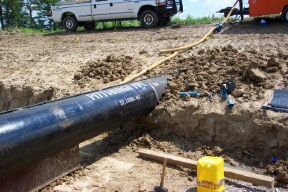Trenchless Technology - What It's All About
I'm still amazed that more people don't know about trenchless technology, the means by which underground utility product pipes are installed and repaired. It happens on a daily basis in the US, and worldwide as well. I promised to give the whole scoop here, and this post is the start of that.
We use underground utilities every day. Water. Natural Gas. Sewer. Phone. Electricity. Cable Television. Sure you've got a lot of this stuff (phone, CATV, and electricity) up the poles, poles (though they're cheap to install and maintain) make a negative aesthetic statement. Stuff like water and sewer, which you have to bury below the frost line, are ALWAYS underground. EVERYBODY needs utilities.
Now, what happens when you need to install a new water line, for instance? Do you dig down 6 feet or so, put a man in a trench, and connect the big ductile iron mains or PVC laterals by hand? OK, how wide is your trench? Is the man going to be down in the bottom of the trench? WHAT HAPPENS WHEN THE TRENCH WALL COLLAPSES? Needlessly in the US, utility men and others die as the result of trench collapse. They can't get the people out of the trench fast enough to prevent them from suffocating. Trenchless installation involves NO TRENCH....so you can't have a trench collapse on somebody's mom or dad...which could lead to their DEATH. This is NO JOKE.
Why did I decide to get involved in this? I saw a better way of doing what we're all accustomed to, in burying our underground utilities. Also, there's only one way to insure success when putting a pipe underground with a trenchless method of horizontal boring. You should know IN ADVANCE what type of soil or rock you're putting it through, so that you can choose the right method for the job, and the right type of pipe.
Pipe ramming is one method that's used . The photo here is of a pipe ram that we did in 2002 at the University of Missouri Capsule Pipeline Research Facility, near Columbia, Missouri:

The pipe is actually being driven into an embankment by the use of a reciprocating hydraulic hammer, called a pipe ram, attached to the end of the pipe. The end of the pipe being driven in has a reinforced steel leading edge that will crack its way through any boulder or cobble in the path of the pipe. It's VERY effective. The main problem with this method is that it takes more time to weld each new section of pipe on than it does to ram a section of pipe in. It's also 'dumb', meaning you don't have a whole lot of control over the line and grade of the pipe once you start ramming it through.
Still, it's a great method to use. We decided to use this method here because there might be possible glacial erratic boulders of quartzite or basalt in the clayey glacial till we drove it through.
Trenchless Geologist

0 Comments:
Post a Comment
<< Home